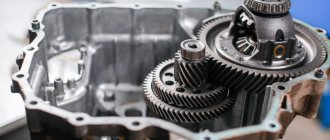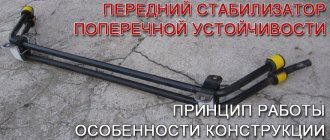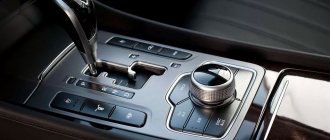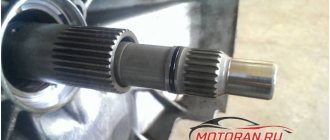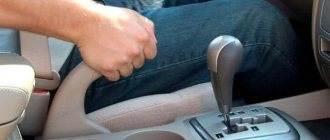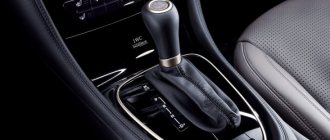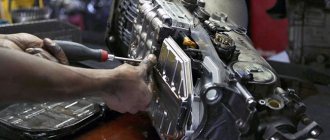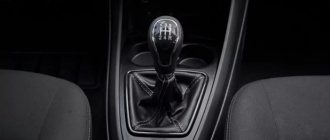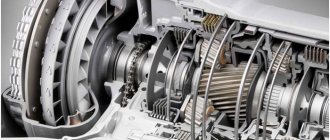The active development of the automotive industry continues today thanks to the introduction of the latest technologies in this industry. In modern cars, the manufacturer invests a large margin in terms of dynamic and power characteristics, improves the level of equipment, safety, etc.
At the same time, a lot can depend on the quality of implementation of a particular technical solution, including the life and health of the driver, passengers, and other road users.
Note that, given the great popularity of automatic transmissions, the “S” (Sport) mode is designed to fully experience the “drive” of driving a car. Also, this mode can help the driver in a difficult situation. In this article we will look at what “S” gear is on an automatic transmission, why this mode is needed and how to use it.
Band D: Drive mode
The car is most often in the Drive position. Used when moving under standard conditions. Including the transition from first to fourth gear occurs automatically as needed.
To enter this mode, you need to slow down a little and move the lever to position D. Then the transmission turns on within one second. Afterwards you can start moving.
The advantage of the mode is that the box performs actions automatically. The driver just needs to regulate the speed of the car by pressing the gas pedal. Only when the lever is in D can the car reach maximum speed.
How to use an automatic transmission correctly
Makes maximum use of engine power. In this regard, switching to higher gears is carried out at maximum speed. Due to this, the car accelerates with high acceleration. The “sport” mode of the automatic transmission is used with the appropriate driving style.
Nowadays, it is difficult to imagine a modern car that is not equipped with an automatic transmission. However, not all modern drivers know how to use this unit correctly. They do not turn on the winter mode of the automatic transmission in cold weather and use other modes not in accordance with the needs of the car. The consequences of this are very dire - the automatic transmission may break.
Band P: Parking mode
During installation, the output shaft is blocked and vehicle movement becomes impossible. The “Parking” mode should only be activated when the car has completely stopped moving. If parking is planned on a slope, first turn on the handbrake, and in the next step move the lever to the Parking position. This is done because when removing the position, the blocker will be under load and it will be difficult to perform such actions.
How it works: why do you need manual mode in an automatic transmission?
The same applies to situations when the serpentine road leads upward - unlike a wavy road, where you can save money by increasing the gear, on steep hills the gears will have to be lowered. To make it easier to overcome them. Why, if the automatic transmission will downshift on its own? You don’t have to lower it, but if it’s descent-ascent-turn-descent-ascent, it will be much easier to control the situation yourself.
So, you are ready to go to Crimea (if you are not already on your way). Let's say you decide to go to a resort from Kyiv. Of course, by car. What is important when driving long distances? That's right, savings. Of course, for some it is also important to get there quickly, but now let’s talk about those who want to save money.
Interesting read: Consequences of working with two work books
Band N: what is the neutral mode for?
The handle is located between o and “Drive”. After the automatic transmission is moved to the equilibrium position, the rigid connection between the drive and driven shafts is lost and the car has the opportunity to move freely.
This mode should only be used when towing a vehicle. Even when the engine is not running, oil circulates in the box, which has a beneficial effect on the unit. It is not recommended to use “Neutral” while coasting as the position is for service, not work.
Operating principle of automatic transmission
It is forbidden to switch automatic transmissions because the automatic transmission is not capable of switching quickly, as, for example, owners of manual transmissions do. It's all about the operating principle of the automatic transmission.
- When the engine starts, the pump wheel and turbine begin to rotate. They push the lubricant, which here not only plays a passive role as a lubricant, but also participates as a pressure regulator. This work occurs under the influence of centrifugal force.
- The oil flies back, landing on the reactor blades. And from there it hits the pump wheel with higher force, increasing the rotation speed of the internal combustion engine.
- The fluid coupling makes the planetary gearbox work.
- And it is already controlled by the hydraulic unit, which, together with the electronic control unit, is the main “brain” of the entire automatic transmission system.
- It launches an algorithm for fixing the components of the planetary gearbox and forces it to automatically change gears in the box.
Read
Diagnosis and repair of Mazda automatic transmission with your own hands
The automatic transmission does not allow the engine to operate at full power, thereby maintaining its health and increasing its service life.
Attention! On vehicles with automatic transmission, you cannot start abruptly from a standstill or start driving with an unheated transmission in the cold season. This will lead to rapid wear of the machine’s components and will speed up the time for major repairs or even restoration of the box.
The correct method for controlling the machine is as follows:
- Turn on the ignition. Allow the vehicle to warm up to operating temperature for three minutes.
- Press the brake pedal. Switch the automatic transmission selector knob to the “Forward” or “Reverse” position.
- Release the brake and press the gas without sudden movements. Don't accelerate from the start.
In winter, be sure to warm up the machine for five minutes. You can switch the selector handle while pressing the brake pedal before the car owner moves away. This will allow the oil to get into all automatic transmission components and lubricate them before driving.
Read
How to remove and install automatic transmission
Overdrive mode
Needed to use the inertial component of the engine while moving at high speed. In an automatic transmission, such transmission is considered direct. She is fourth in a row. If you compare it with a manual transmission, then the speed there is fifth.
Overdrive is activated via a button located on the selector or placed separately. If this operating mode is set, direct transmission is switched on automatically after the car reaches high speed. This allows you to significantly save fuel. In practice it happens from 50 km/h.
It is not recommended to turn on Overdrive in winter and when driving with a trailer. A bad road requires engine braking, but in this case this becomes impossible.
Mode "D" or "Drive"
The fourth main mode on an automatic transmission is the “Drive” mode, the main driving mode intended for driving the car forward. Most often indicated by the “D” icon and is located immediately after the “Neutral” mode. It turns on before you start driving and turns off by moving the selector to the “Parking” mode after it ends.
It is worth saying that on many cars the “Drive” mode has special protection against spontaneous activation, so it can only be turned on after pressing the brake pedal and/or pressing a special button on the automatic transmission selector.
Mode S – sport on automatic
Refers to additional automatic transmission provisions. You can turn it on with a special button located next to the box selector. The car will begin to respond faster to the gas supply and gain speed more intensely. You can switch on the go. There is no need to stop the car.
It is convenient to use “Sport” in the following situations:
- overtaking when it is necessary to sharply increase speed;
- used in urban environments;
- on a steep descent, engine braking is much more effective.
Some drivers love S mode so much that they use it in everyday driving.
D.S.
During operation, the engine produces higher speeds, and with the accelerator pedal in a standard position. By increasing the gas supply, the engine reacts more sensitively to such changes.
In fact, this is the same sport mode, which is used in the speed range from 40 to 120 km/h. The moment of switching on can occur while moving or at a stop. If you drive less than 40 km/h, the box automatically switches to standard operation. Including Ds, it is convenient to brake with the engine.
Sequential mode
It is also called “manual”. Used when moving at high speeds. Switching speeds occurs smoothly and without difficulty. Can be activated on the go or in advance when the car is stationary.
How to use automatic transmission correctly
It should also be clarified that owners of automatic transmissions who have switched from manual transmissions are offered transmission configurations with the possibility of independent manual gear shifting. This function first appeared on Porsche cars and was designated “tiptronic”.
Interesting to read: Subsidy for young families for the purchase of housing 2021 Lipetsk region
However, if the car already has an automatic transmission on board, how to use it correctly? It is worth initially at least briefly familiarizing yourself with the principle of its operation. After all, it has significant operational features when compared with a mechanical unit.
How to enable economy mode of automatic transmission
A series of manipulations should be carried out with the lever. Switching is carried out in the following order: RPRNRP and Eco mode is activated. Saving of fuel mixture occurs as a result of engaging a higher gear at lower speeds. The operating mode of the torque converter lockup changes. Remember that too low speeds are detrimental to the engine due to the lack of normal oil pressure.
How to use an automatic transmission correctly
Additional modes make it possible to make wider use of the automatic transmission's capabilities.
They are used depending on the road surface, the driver’s mood, and the situation on the road. As a rule, they are implemented through electronics that control the hydraulic system of the unit. Makes maximum use of engine power. In this regard, switching to higher gears is carried out at maximum speed. Due to this, the car accelerates with high acceleration. The “sport” mode of the automatic transmission is used with the appropriate driving style.
Position M (Manual): manual mode
You can use an automatic transmission just like a manual transmission. Also called manual. Before you turn it on, you need to learn how to use it correctly.
To set the position, lower the lever down and move it to the left. Some gears contain numbers: 1,2,3,4. These are speeds that are switched manually.
The need arises when driving on bad roads. The manual mode is needed to reduce the load on the machine, which constantly changes gears during the movement process. This leads to increased wear.
By setting it to M, no speed is automatically switched on. The driver independently regulates the movement using a lever, moving it to the desired numbers.
Is it possible to switch automatic transmission on the fly to manual and back?
While driving a vehicle, manual transmission control can be activated at any time. If necessary, the lever returns to the reverse position. This does not depend on the condition of the car. At this moment he can move or stand still.
Switching the automatic transmission selector on the go
Some car owners do not follow manufacturers' recommendations and overload the box. Therefore, many beginners wonder whether it is possible to switch the automatic transmission on the go. And will there be problems with it in the future?
There are several modes into which the automatic transmission cannot be switched without stopping the car.
Switching from D to N
Beginners are wondering whether it is possible to switch from position “D” to “Neutral” while driving. Such action is prohibited. Because with this switching, the automatic transmission will lose contact with the wheels of the car. And this process can lead to an emergency on the road.
In the “Neutral” position, the engine is disconnected from the machine, but the car does not slow down. If you constantly switch “D” to “N”, this will lead to failure of the device.
Therefore, the best option would be the following automatic transmission switching procedure:
- Press the brake pedal. Wait until the car slows down.
- Switch the automatic transmission to the “Neutral” position.
In driving schools, it is prohibited to coast towards a traffic light at “N”. In this case, the student may not pass the exams.
Read
Reasons for automatic transmission slipping when shifting
In this position, you can only tow the vehicle if it is faulty, but not switch to it. It is not recommended to delay this procedure. You need to take breaks every 100 kilometers if the towing distance is more than one hundred kilometers. The process itself should occur at a speed of no more than 40 km/h.
Switching from "D" to "S"
“S” is the sport mode of the automatic transmission. You can switch the automatic transmission using a button located on the selector. In it, switching to increasing speeds when driving occurs at higher speeds. For driving on the autobahn, it is recommended to switch the automatic transmission to this position.
Beginners are also interested in whether it is possible to switch the automatic transmission on the go from “D” to “S”. Since this is just a program for the machine, nothing changes in the box itself when turned on. Therefore, when the selector knob is in the “Forward” position, it is possible to switch to sports mode.
The "D" or "Drive" position allows the transmission to automatically shift from first to fourth or sixth gear without human intervention.
Read
Replacing the oil filter in an automatic transmission
Switching from "D" to manual mode
Answering the question whether it is possible to switch the automatic transmission on the fly to manual mode, it should be said that it has three handle positions. And for each there are certain rules.
- The first mode is numbered “1” or “L”. It is recommended to switch the automatic transmission to it during the start, when entering a garage, or when driving in mud or snowy areas. The maximum speed at which the automatic transmission can be switched to this manual mode is 25 kilometers per hour. At a speed exceeding this number, the machine may fail.
- It is recommended to switch the automatic transmission to mode number “2” when the vehicle is moving at a speed of no more than 50 km/h. The car owner can drive in this mode through wetlands or dangerous dirt roads. Experts prohibit exiting “Forward” to position “2” at a speed that exceeds 80 kilometers per hour.
- “3” – movement in third gear. Experienced car owners recommend switching the automatic transmission to this position when driving with traffic jams and traffic lights in the city. In this mode, gear shifts automatically to third. You cannot switch to this position immediately from a speed above 120 km/h.
Read
Automatic transmission and trailer, or is it possible to haul a trailer with an automatic transmission?
On machines with tiptronic there is a special mode called “M” from the English “Manual” or manual. It allows the driver to control the car accurately and reach speed faster. The car owner can switch the selector knob to this position at any time and at any speed.
On vehicles with tiptronic, you can change down and up gears. They are marked with plus and minus signs, respectively. On such vehicles, it is also allowed to brake through a lower gear if the selector is set to manual mode.
L mode
If you transfer to a manual transmission, this corresponds to first gear. The lever can be shifted while the machine is moving. The position is used when moving the car on bad roads or ice. It is used on descent or ascent.
Including, a lower gear is engaged in the box. During this period, the car provides good traction, but maximum fuel consumption is observed.
How to use an automatic transmission
Experienced craftsmen believe that the machine should be given a short “rest”. This means that the car must be allowed to idle for a few seconds. It is worth noting that even in a car with a powerful engine, sudden movements will significantly reduce the life of the box.
Today, most drivers have no idea how they would drive a car that does not have an automatic transmission. Some beginners are horrified at the thought of having to constantly change gears manually. Many experienced drivers also realized long ago that driving with an automatic transmission is much more convenient. Despite all this, people are tormented by the question - how to properly operate an automatic transmission? This article will discuss exactly this.
Power and Hold modes
The first is briefly designated - Pwr. Including, the engine has the opportunity to operate at high speeds for a long time. This is ensured by a delay in switching to higher gear. For this reason, the clicking sound occurs when the car reaches maximum speed. Downshifting occurs instantly.
The purpose of the Hold option is to engage second gear, starting to move the car. If there is a good road ahead, the box will switch to third. The mode provides certain conveniences during steep descents. It does not allow the car to gain high acceleration due to the braking effect. Including Hold, the car cannot move above 40 km/h.
These two buttons can be located on the automatic transmission handle, on the side or near the dashboard.
Letter designations on the automatic transmission box
Surely every car driving instructor, and not only him, once wondered - what do these strange letters on an automatic transmission mean and what are they for? These letters indicate the operating modes of the box. They can be located on the shift knob or on buttons located on the transmission control panel. We conduct an educational program for the uninitiated and decipher their meaning.
1. P (parking) – transmission lock used when parking, literally – parking.
2. R (reverse) – reverse movement, reverse gear, literally – reverse.
3. D (drive) – forward movement, literally – driving, control.
4. N (neutral) – neutral position, that is, disconnecting the wheels from the transmission, literally – neutral.
5. A (automat) – automatic activation of all speeds.
6. L/B (low/bottom) – slow motion, low gear. If there is also the number 1, then this may indicate a different meaning of this letter - it may mean differential locking, which absolutely cannot be engaged while driving.
7. 2/2L – forward movement automatically at speed not higher than second.
8. 3 – the same forward movement, but at a speed no higher than third gear.
9. M (manual) – manual control. Usually accompanied by “+” and “-” markings.
+ means forced shifting to a higher gear.
— forced switching to a lower gear level.
10. S (sport) – “sport” mode provides gear shifting at the highest speeds.
11. OD (overdrive) – function of switching to the highest possible gear. It can be in the “on” position—enabled or “off”—disabled.
12. W (winter) – mode for winter, standing start in this mode is carried out from second gear. In some cases, instead of a letter there may simply be a sign depicting a snowflake.
13. E (economic) – fuel saving mode, smoother gear shifting process.
Many driving instructors, and not only them, sometimes have doubts about the I icon and its meaning. In fact, this is not the capital letter of the English alphabet i, but the capital letter L - l, or the number 1, and it has the same meaning as the marking low - slowing down, reducing gear.
This is how those mysterious signs on the gearbox are deciphered in a simple way - as you can see, nothing complicated.
- Svetlana
Transmission: AutomaticCar: Kia Spectra automatic transmission, training on your car is possible
Driving experience: 18 years
Study area: Eastern Administrative District, South-Eastern Administrative District, Ryazansky Avenue, Volgogradsky Avenue, Oktyabrsky Avenue, Verkhnie Polya St., Lyubertsy, Kotelniki, Reutov
Lesson hour: automatic transmission - 750 rub.
Training methods: I will help you master and hone your driving skills on site, in dense city traffic, teach you to cope with difficult situations on the road, help you thoroughly prepare for passing exams at the traffic police More details
36 student reviews
- Svetlana
Transmission: manual transmission, automatic transmissionCar: Chevrolet Lanos manual transmission, Hyundai Accent automatic transmission, training on your car is possible
Driving experience: 17 years
Study area: Northern Administrative District, North-East Administrative District, Lobnensky, Pyalovsky traffic police routes, Dolgoprudny
Lesson hour: manual transmission - 650 rubles, automatic transmission - 750 rubles
Teaching methods: I teach driving at any level. Based on driving skills, the training program for each student is selected individually. There is an equipped area for training from scratch. More details
54 student reviews
- Natalia
Transmission: APPCar: Kia Spectra automatic transmission
Driving experience: 17 years
Study area: SZAO, ZAO, Khimki, Kurkino, Mitino, Krasnogorsk, Stroginsky traffic police routes and Khimki traffic police route
Lesson hour: automatic transmission - 750 rub.
Training methods: I help you overcome fear and uncertainty on the road, quickly gain or restore all the necessary driving skills. During classes, a friendly, calm atmosphere is created, and I provide an individual approach to the student. More details
59 student reviews
- Hope
Transmission: manual transmission, automatic transmissionCar: Chevrolet Lanos manual transmission, Kia Spectra automatic transmission, training on your car is possible
Driving experience: 18 years
Study area: Northern Administrative Okrug, Lobnensky, Pyalovsky traffic police routes, Khimki traffic police route, Dmitrovskoye highway, Altufevskoye highway, Leningardskoye highway, Khimki, Dolgoprudny
Lesson hour: manual transmission - 650 rubles, automatic transmission - 750 rubles
Teaching methods: Good afternoon. I help novice drivers practice their skills before passing the traffic police exams on the Lobnensky, Pyalovsky routes and the exam route in Dolgoprudny and Khimki. In just a few lessons, we will thoroughly prepare for the exam, reviewing and working through the exam route in detail. More details
58 student reviews
- Oksana
Transmission: manual transmission, automatic transmissionCar: Chevrolet Lanos manual transmission, Kia Spectra automatic transmission, training on your car is possible
Driving experience: 17 years
Study area: Central Administrative District, South-Western Administrative District, Southern Administrative District, South-Eastern Administrative District, Warsaw traffic police route, Kashirskoe highway, Varshavskoe highway, Leninsky prospect, Kutuzovsky prospect, Volgogradsky prospect, Michurinsky prospect, st. Profsoyuznaya, st. Lublinskaya; cities: Vidnoye, Podolsk, Domodedovo, Vnukovo, Dzerzhinsky
Lesson hour: manual transmission - 650 rubles, automatic transmission - 750 rubles
Teaching methods: I will help you prepare for passing the traffic police exams along the Warsaw (Butovsky) route and in Vidnoye. We will look at each section of the route, learn how to properly navigate roundabouts, complex intersections, make turns, turn around, and much more. More details
36 student reviews
- Eugene
Transmission: manual transmission, automatic transmissionCar: Chevrolet Lanos manual transmission, Chevrolet Aveo automatic transmission, training on your car is possible
Driving experience: 24 years
Study area: Northwestern Administrative Okrug, Northern Administrative Okrug, Khimki, Dolgoprudny, Lobnensky and Pyalovsky traffic police routes, Khimki traffic police route, Dolgoprudny traffic police route
Lesson hour: manual transmission - 650 rubles, automatic transmission - 750 rubles
Training methods: When it comes to driving, you need to be equally well versed in both theory and practice. If you feel that the knowledge you were given in driving lessons is not enough, then it’s time to turn to a private instructor. I can quickly prepare you for the Lobnensky, Pyalovsky, Dolgoprudnensky and Khimki traffic police examination routes. More details
44 student reviews
- Elena
Transmission: AutomaticCar: Chevrolet Lacetti automatic transmission, training on your car is possible
Driving experience: 16 years
Study area: Central Administrative District, South-Western Administrative District, Southern Administrative District, South-Eastern Administrative District, Warsaw traffic police route, Kashirskoe highway, Varshavskoe highway, Leninsky prospect, Kutuzovsky prospect, Volgogradsky prospect, Michurinsky prospect, st. Profsoyuznaya, st. Lublinskaya; cities: Vidnoye, Podolsk, Domodedovo, Vnukovo, Dzerzhinsky
Lesson hour: automatic transmission - 750 rub.
Teaching methods: I will teach you everything you need from understanding the dimensions of a car to confidently driving on city roads. Let's overcome fear of the road after an accident. We will restore lost skills or improve existing ones. More details
46 student reviews
Transmission: manual transmission, automatic transmission
Car: Daewoo Nexia manual transmission, Chevrolet Aveo automatic transmission, training on your car is possible
Driving experience: 16 years
Study area: Northern Administrative Okrug, Lobnensky, Pyalovsky traffic police routes, Khimki traffic police route, Dmitrovskoye highway, Altufevskoye highway, Leningardskoye highway, Khimki, Dolgoprudny
Lesson hour: manual transmission - 650 rubles, automatic transmission - 750 rubles
Teaching methods: Many people fail their driving test because of anxiety. They know the theoretical part very well, but the lack of practice in driving a car makes many students feel insecure. Want to learn all the car driving skills? I can quickly prepare you for the exam Read more
58 student reviews
Transmission: Automatic
Car: Chevrolet Lacetti automatic transmission, training on your car is possible
Driving experience: 13 years
Study area: Eastern Administrative District, North-Eastern Administrative District, South-Eastern Administrative District, Balashikha, Zheleznodorozhny, Lyubertsy, Mytishchi, Entuziastov highway, Shchelkovskoye highway, Yaroslavskoye highway.
Lesson hour: automatic transmission - 750 rub.
Training methods: I will teach you the features of driving a car with an automatic transmission, help you master the technique of parking in a confined space, and acquire the skills of masterfully driving a car. After the course, you will be able to deftly maneuver in city traffic. More details
59 student reviews
Transmission: manual transmission, automatic transmission
Car: Chevrolet Lanos manual transmission, Kia Spectra automatic transmission, training on your car is possible
Driving experience: 19 years
Study area: North-Western Administrative District, Stroginsky traffic police route, Khimki, Kurkino, Mitino, Krasnogorsk
Lesson hour: manual transmission - 650 rubles, automatic transmission - 750 rubles
Training methods: I have been training future drivers for many years, so by turning to me for help, you will receive an experienced and knowledgeable mentor in my person. During the lessons, we will analyze the Stroginsky traffic police examination route down to the smallest detail: difficult sections, turns, features of roundabouts and much more. More details
131 student reviews
Transmission: Manual
Car: Chevrolet Lanos manual transmission, training on your car is possible
Driving experience: 14 years
Training area: Northern Administrative Okrug, Lobnensky and Pyalovsky traffic police routes
Lesson hour: manual transmission - 650 rub.
Teaching methods: I am preparing for exams on the Lobnensky and Pyalovsky traffic police routes. In a short time I will teach you all the rules of driving a car with a manual transmission. Together with you, we will study in detail each section of the exam route, learn how to make right and left turns, U-turns, stops, drive through complex intersections and much more. More details
116 student reviews
avtoinstruktor199.ru
How does an automatic transmission work: the operating principle of an automatic transmission
And in the torque converter, in place of the impeller and turbine, imagine two ordinary propellers. One of them is powered by electricity, and the other rotates due to the air flow generated by the first. The role of air in the gas turbine engine is played by oil, and the first propeller drives the connection with the engine.
Using computer sensors, the car determines when to change speed mode and gives a signal to engage or disable the appropriate gear. The beauty of the automatic transmission is the ability to change acceleration using a small package of friction discs.
Mechanics: reliability and popularity
The most popular among car enthusiasts is a manual transmission. The principle of its operation is the operation of two gears, one of which is rotated by the engine, the second transmits rotation to the wheels. Switching is done mechanically - the driver, using the shift lever and clutch pedal (working together with the gas and brake pedals), selects the required gear, which determines the torque and speed of the car. This is what causes difficulties for beginners - you need to be able to competently switch between speeds, smoothly release the clutch and know at what moment to turn on a particular speed. The mechanics can be installed on any type of drive (rear, front or all-wheel drive).
Mechanics are much cheaper to maintain and repair compared to other gearboxes. Cars with manual transmission are also cheaper than their opponents. Structurally, it is also simpler than other options, which is why repair/replacement will cost less for your pocket than with other gearboxes.
The great popularity of mechanics is explained by the fact that it allows you to own a car to a greater extent than other gearboxes allow. With a manual transmission, the driver decides which gear to engage, and therefore the speed and torque are under his complete control. Thanks to this, fuel consumption with such a box is the lowest. Thus, mechanics have the highest efficiency among other gearboxes.
To summarize the above, it is worth briefly summarizing the pros and cons of a manual transmission. Among the advantages it is worth highlighting:
- lowest cost;
- simplicity of design;
- lower fuel consumption than cars with other gearboxes;
- high operating efficiency, allowing you to operate the car as well as possible;
- excellent dynamics.
The only downside is the need to constantly move the lever and pedals.
Automatic: convenience and ease
The second most popular gearbox today is automatic. It is a kind of “complicated” mechanics, to which a mechanism has been added that independently changes gears. The driver only needs to select one of four modes (park, neutral, reverse and drive - drive) and press the pedal, and the automatic will do the rest for him. As for the pedals, there are two of them: gas and brake, there is no clutch. From the point of view of ease of driving, an automatic transmission allows you to drive it carefree and simply, without requiring constant interaction with the lever and pedals - just selecting the desired mode and pressing the gas pedal. A good stepped transmission option for a carefree ride.
But, given the more complex design of this box, it is worth taking into account its higher cost (both when buying a car, and in case of repairs if a breakdown occurs, or other maintenance). By the way, an automatic transmission weighs more than a manual transmission, which is why the car will have a slightly higher mass. You will also have to increase fuel costs, because the automatic transmission “eats” more than its main competitor, the manual transmission. These two gearboxes have quite a lot of differences, so many car enthusiasts ask the question: which is better, a manual or an automatic, the differences in each of which are visible even to the naked eye (from cost to principles of operation and operation).
The advantages of the machine include:
- convenient driving without the need to change gears;
- the ability of the automatic transmission to change gears at maximum engine power;
- no rollback when starting on a flat road surface;
- increased service life due to the protection of the gearbox, which is why it is not afraid of overload and malfunction due to incorrect gear shifting (mechanics in the hands of beginners in this case invariably suffer);
- built-in anti-rollback system, which helps prevent spontaneous movement of the car while parking.
Among the disadvantages:
- higher (compared to manual) fuel consumption;
- high cost of purchase, repair, maintenance;
- dynamics inferior to manual transmission;
- time delays when changing gears;
- rollbacks when starting on an inclined area.
From the above it is clear that manual transmissions and automatic transmissions have a wide range of differences, and therefore the question - which is better than a manual or an automatic transmission - can be considered quite logical.
Automatic transmission - how to use? Automatic transmission switching and control modes
It is strictly forbidden to load a machine that is not warmed up. Even if the air temperature outside the car remains above zero, it is best to cover the first kilometers at low speeds - sharp accelerations and jerks are very harmful to the gearbox. A novice driver should also remember that in order to fully warm up the automatic transmission, it takes more time than to warm up the power unit.
If you need to stop at a traffic light, or in case of traffic jams, do not set the selector to the neutral position. It is also not recommended to do this on descents. If the car is slipping, then you do not need to press hard on the gas - this is harmful. It is better to engage in lower gears and use the brake pedal to let the wheels rotate slowly.
What does mode - S - mean on an automatic transmission?
Operating the automatic transmission is quite simple - turn on mode D (drive) and go. Naturally, there are modes: R (reverse), P (parking) and N (neutral) for short technical movement of the car. But many modern automatic machines also have an S mode. Let's figure out what it is, why it is needed and how it affects the operation of the engine, transmission, suspension and steering?
Now let's talk about how this happens. Sport mode changes the transmission itself, or rather the number of gears and ratios, allowing the engine to reach maximum speed and, accordingly, produce more power. And that is not all. When mode S is turned on, the on-board computer comes into play, making the suspension stiffer, the steering clearer, sportier, and the car reacts more sharply to steering movements.
Automatic or manual transmission
Let us compare the two types of transmissions in terms of their advantages and disadvantages. We will take the following criteria as a basis: price, maintenance and repair, efficiency and acceleration, reliability, service life, winter driving conditions, comfort, clutch and engine life, and vehicle behavior on the road.
Maintenance and repair
Maintenance and repair of a car with an automatic transmission will be more expensive. An automatic requires more oil than a manual, and it costs more. The oil filter also requires replacement. Compared to an automatic transmission, a manual transmission is easy to maintain and does not require expensive consumables and spare parts.
Efficiency and acceleration
The acceleration dynamics of a manual transmission are better than those of an automatic transmission, and the efficiency of a manual transmission is higher. A manual transmission makes it possible to realize all the engine power and torque. The exception is robotic transmissions with two clutches.
Reliability
The simplicity of the device compared to an automatic transmission allows manual transmission to claim the title of a more reliable gearbox. Towing over long distances with a flexible or rigid hitch is only possible for vehicles with a manual transmission. It is recommended to transport a car with an automatic transmission only on a tow truck. The operation of a car equipped with a manual when driving in icy conditions, through mud and off-road will be better compared to an automatic.
Service life
And this criterion speaks in favor of mechanics, whose service life is longer. Some manual transmissions can function even after the original car engine fails. The same cannot be said about the automatic transmission, which will only last until overhaul.
Winter driving
It is easier to drive a manual car on slippery surfaces and skid in the snow. For an automatic machine, these actions are not advisable - the transmission oil may overheat.
So, for the six items under consideration (price, maintenance and repair, efficiency and acceleration, reliability, service life, winter driving conditions), a manual gearbox wins. Let's see how the machine responds.
Comfort
Automatic transmission operating modes
An automatic transmission has a higher level of driver comfort than a manual transmission. Even an inexperienced driver will be able to move off calmly and without jerking, without creating an emergency situation. Mechanics require increased concentration and attention from the driver. Constant gear changes and the need to constantly depress the clutch pedal, especially in city traffic jams, tire the driver.
Engine and clutch life
In this regard, the automatic also benefits: it controls the speed and prevents the engine from overheating. On a manual transmission, incorrect gear shifting may result in engine overload. Beginners may forget and fail to change gears from low to high in time, causing the engine to operate at higher speeds.
The same applies to the clutch. In a car equipped with an automatic transmission, there is no need to constantly disengage the clutch.
Car behavior on the road
A car with an automatic transmission moves smoothly, without jerking, and does not roll away on a hill. The machine has a “parking” mode, in which the engine is disconnected from the transmission and the output shaft of the box is mechanically locked. This mode allows the machine to be held securely in place.
Well, three against six! Is a manual better than an automatic? May be. But developers do not stand still and come up with new and increasingly improved varieties of automatic transmissions. If we take, for example, the acceleration of a car as a criterion, then a manual transmission accelerates faster than a classic automatic transmission, and in terms of efficiency it is definitely not inferior to a manual transmission, and sometimes even surpasses it.
Possible operating modes of the adaptive automatic transmission
As mentioned above, this type of box selects a gear, taking into account the driver’s driving style. She supervises driving a car in the most popular modes.
winter mode
The features of this mode make it possible to drive confidently on icy roads. The vehicle is virtually guaranteed to start on a slippery surface. In this mode, emergency braking is also possible, carried out by the motor and preventing the car from significantly increasing the braking distance on a slippery road surface.
Winter mode does not have a clear speed priority. Only the start is actually always made from third or second gear.
sport mode
Sport mode controls and provides a sporty driving style. It allows you to quickly accelerate and brake quickly. The engine in sport mode operates at full power, which increases the fuel consumption rate, although this has a good effect on the dynamics of the car.
economy mode
When switching to this mode, the system will function in the direction of reducing the amount of fuel consumed. The vehicle does not force itself and drives very smoothly. In economy mode, low gears are given priority.
How to start driving an automatic car lesson 2 AUTOMATIC
Today we will talk about how to start with an automatic transmission. 1) Get behind the wheel and check that the car should be in “P” mode - parking (you don’t have to use the handbrake), or “N” - neutral (then you need to use the handbrake). This is how easy it is to get going in a car with an automatic transmission.
How to drive an automatic vehicle at a traffic light to be first:
When the light turns green, press the gas pedal. The faster you press the pedal, the faster your car will start.
For many, it will be easier to comprehend the “basics” of a successful start in a car if you understand what happens inside the transmission as a result of their actions (pressing the clutch pedal, shifting gears). But in a manual transmission, to change gears, the driver needs to squeeze not only the clutch, but also “turn” the gearbox lever. In this case, the clutch must be kept pressed, and the accelerator (if the car does not stall) can be released. Then, to prevent the car from stalling, the accelerator should be held lightly for a while. It is especially difficult to start from an incline in a car equipped with a manual transmission. There are two main ways to start up a hill. Let's consider each of them separately. At the moment when you feel that the car has moved forward up the hill, and only the parking brake is holding it, release the handbrake button.
How to drive an automatic transmission?
However, driving an automatic transmission is not as simple as it seems at first glance, and therefore the question of how to drive an automatic transmission is far from idle. In this case, the engine should be started in the selector positions “P” or “N”. In other positions the car simply will not start. In this case, it is necessary to hold the car by pressing the brake pedal. However, turning on this mode is possible only when the vehicle speed is below 15 kilometers per hour. Before driving an automatic transmission off-road, it is better to turn on the mode in advance. Before driving an automatic transmission using this mode, you should remember that it forcibly does not allow the automatic transmission to shift higher than third gear. This legend arose from the fact that in the standard “drive” mode the car actually does not slow down due to the power unit.
How to drive off with a manual transmission at a traffic light with throttle shifting:
These include the ability to start from a stop, the ability to start up a hill and driving in reverse. Without mastering these three basic maneuvers, driving a car is simply impossible. First of all, you should understand that in order for the car to move, the rotating motor and the car chassis must be connected. Without going into the details of the design, let's just say that the clutch pedal in a car with a manual transmission is exactly what is needed to smoothly, without jerking, connect the engine and wheels. Learning to drive a car with an automatic transmission is not a very quick process. In some cases, it becomes necessary to quickly pick up speed with minimal slippage - for example, to overtake a car at a traffic light.
Just like a manual car, to drive a car with an automatic transmission, you need to start it and warm up the engine
It is also important to remember to release the car's handbrake.
